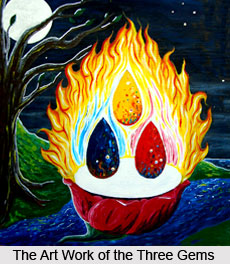 Taking refuge in the Triple Gems, makes one a prefect Buddhist. The Triple Gems of Buddhism comprise of the Buddha, the Dhamma and the Sangha. These are called Triple Gems because they represent three principles, which should be treasured like gems. Triple Gems is also known as Three Gems, Three Treasures and Three Refuges. A true Buddhist will, therefore, revere Gautama Buddha, learn and follow the Dhamma and be advised by the Sangha.
Taking refuge in the Triple Gems, makes one a prefect Buddhist. The Triple Gems of Buddhism comprise of the Buddha, the Dhamma and the Sangha. These are called Triple Gems because they represent three principles, which should be treasured like gems. Triple Gems is also known as Three Gems, Three Treasures and Three Refuges. A true Buddhist will, therefore, revere Gautama Buddha, learn and follow the Dhamma and be advised by the Sangha.
Buddha is considered the first Gem because he was the founder of Buddhism. He is the most respected person amongst Buddhists. He found Truth and represents wisdom. The Dhamma is the means to achieve Truth and happiness. The third gem is the Sangha, which is the religious institution comprising of the monks, nuns and the lay followers. It also stands for purity. The Three Gems of Buddhism enables an individual to achieve a mind like a mirror.
To become Buddhist student one has to take refuge in the Three Gems and follow the Five Moral Precepts as well.
The Five Moral Precepts are as follows:
• Avoid Lying
• Avoid Using Intoxicants
• Avoid Killing
• Avoid Stealing
• Avoid Misusing Sex
The term Three Gems has been mentioned in the Pali Canon. In the Ratna-sutta verses on these could be found. In Buddhism Buddha`s mind is frequently associated with a diamond as such a mind can win over anybody.
In Buddhist art the Three Gems are known as triratna. These can be found on Buddha`s footprints and on the Dhamma chakra. The symbols of Triple Gems are on the Sanchi Stupa till date.




















